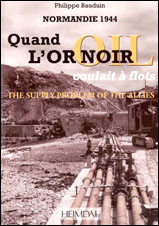English/French bilingual edition.
En raison d’une mécanisation sans précédent, tout ce qui concerne l’approvisionnement en produits pétroliers prit pendant la Seconde Guerre mondiale un rôle de premier plan. Faisant suite à l’opération Overlord, la bataille de Normandie fut le théâtre d’un vaste déploiement de technologies. En marge des combats, qu’ils soient terrestres ou aériens se posait de façon cruciale la question du ravitaillement, en particulier en produits pétroliers. Sans carburant, cette gigantesque opération militaire n’aurait pas pu aboutir : les avions cloués au sol, les blindés à l’arrêt, la cause aurait été rapidement perdue.
Les Alliés planifièrent à cet effet une logistique hardie qui n’empêcha pas la nécessité d’improviser devant certaines défaillances. L’oléoduc trans-Manche PLUTO, le Red Ball Express, impressionnant ballet routier, la réfection rapide du réseau ferré, les trains de péniches sur la Seine, les DC-3 pétroliers, autant d’éléments d’un maillage qui permettra à travers la Normandie de 1944 l’approvisionnement des unités alliées.
Philippe Bauduin s’est fait une spécialité des questions technico-stratégiques de la Seconde Guerre mondiale, et plus particulièrement dans le cadre de la bataille de Normandie. Sur les 80 pages de l’ouvrage, le texte seul en occupe 18, évoquant les problèmes posés par cette logistique complexe autant que cruciale, ainsi que les moyens pragmatiques qui furent mis en œuvre pour les résoudre. Le reste de l’ouvrage est constitué par un riche album de photographies et de cartes, illustrant de façon claire et abondante le sujet évoqué, par des documents généralement édifiants.
Philippe Ballarini
Owing to unprecedented mechanization, everything to do with petroleum supplies had a crucial role to play in World War II. In the wake of Operation Overlord, the battle grounds of Normandy saw technologies deployed on a huge scale. Logistics were a major problem whether fighting in the air or on the ground, with oil and fuel supplies a critical element. With no fuel, this gigantic military operation could never have been carried through, for with aircraft grounded and tanks grinding to a halt, all would soon have been lost.
Accordingly, the Allies made bold logistical plans, which nevertheless had shortcomings calling for improvisation. The cross-Channel pipeline PLUTO, the impressive stream of road traffic known as the Red Ball Express, rapid repairs to the railroads, trains of barges on the Seine, DC-3s transporting oil and fuel, were all pieces in the jigsaw puzzle bringing supplies to Allied units on their way across Normandy in 1944.
Philippe Bauduin specializes in technical questions relating to strategy in World War II, and more particularly the Battle of Normandy. Of the book’s 80 pages, the text alone covers 18, with an account of the problems encountered in the complex and crucial area of logistics and the practical means employed to deal with them. The rest of the book is made up of a rich album of photographs and maps, with plenty of clear illustrations of the ground covered, with generally edifying documents.
Philippe Ballarini
80 pages, 21,5 x 30,2 cm, couverture rigide



